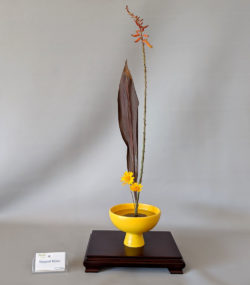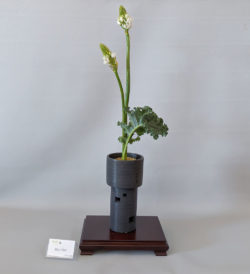
We began our workshop with a presentation of a well-deserved Kakyo (professor 3rd grade) certificate to our rose garden sensei Marylou Coffman.
Then sensei Lauren Toth, a certified rose expert, took center stage and explained the shu (the focal flower or branch or leaf) and the yo (the flower or branch or leaf) that makes the “shu shine.”
Once shu and yo are in place, the arranger needs to decide what might complement them to add interest and give the arrangement visual balance. And since this is a shoka (albeit a modern one), one must remember to keep all the stems in a row and have a proper mizugiwa (the boundary between what is alive and what isn’t).
Lauren’s tip of the day was to arrange the three elements in your hand before placing them in the
kenzan. And her trick of the day was how to make very thin stems stay upright in the kenzan. (Insert the
thin stem into a small piece of a larger stem with a soft center.)
One of the principles of ikebana is the use of local and seasonal materials. Lauren made that easy for us by bringing a plethora of flowers and branches and leaves from her own garden, so that each of us could create an arrangement that represented Phoenix in February!





















